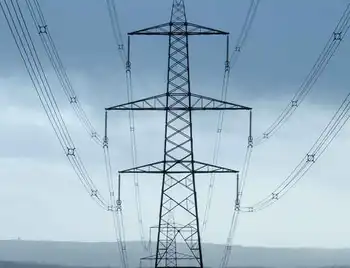Nova Scotia embracing renewable energy
By Toronto Star
Substation Relay Protection Training
Our customized live online or in‑person group training can be delivered to your staff at your location.

- Live Online
- 12 hours Instructor-led
- Group Training Available
The award, received by Dexter at the Copenhagen climate summit in December 2009, recognizes Nova Scotia for creating the first law in North America to put a hard cap on carbon emissions.
"We're a small player, we understand, and I don't want to overstate it, but we're trying to help the country meet its climate change goals," Dexter tells me.
Nova Scotia has been quietly cleaning up its act after decades of clinging to coal. It tabled its own green economy act a year before Ontario, but it garnered little recognition across the rest of Canada.
The 2007 legislation tackles smog-causing emissions, greenhouse gases, and mercury from power generation. Emissions from the transportation sector are also targeted, and goals are established for land and water-resource management.
Dexter says it was a good start, and he credits the minority Conservative government at the time for getting the ball rolling. "But there was never any meat on the bone."
So in April his NDP government released a bold renewable electricity plan that lays out a number of clear milestones, including a legal requirement to have 25 per cent of the province's energy mix consist of renewable power by 2015. On top of that, a goal has been set to grow the green mix to 40 per cent by 2020. Even California hasn't such ambition.
To keep electricity demand from growing, an agency called Efficiency Nova Scotia is being created to promote energy conservation and efficiency. Existing demand, meanwhile, will be increasingly met through a combination of wind, biomass and natural gas.
A feed-in-tariff, similar to that introduced in Ontario but limited to smaller community projects, is also being created to encourage local participation.
En route to the 2020 goal, the province hopes that R&D in tidal energy will begin paying off, and that transmission links to New Brunswick and eventually a subsea power cable from Labrador to Cape Breton to the chagrin of Quebec will open up the opportunity to import clean power.
It's a huge step for a province that, unlike Ontario or Quebec, doesn't get most of its power from hydroelectric and nuclear power generation. Nova Scotia currently depends mostly on coal to generate its electricity. In fact, nearly 90 per cent of Nova Scotia's power comes from fossil fuels.
The reasons are historical. The province used to get coal out of its own Cape Breton mines, but in the world of coal it was the dirtiest of the dirty-loaded with mercury and sulphur dioxide.
Mining peaked in the 1940s and went downhill from there, a combination of resource depletion, production and financial difficulties, and stricter environmental controls. The Westray Mine explosion in 1992 that killed 26 miners didn't help matters.
"It became a very expensive, difficult place to mine," says Rob Bennett, chief executive of privately owned Nova Scotia Power. Disclosure: the company invited me to learn of the energy transition going on in the province and covered the cost of my two-day trip.
But the province, having many coal plants already in place, kept feeding its fossil addiction. The only difference is that it had to shop somewhere else. Today it gets 85 per cent of its supply from Columbia and the United States.
The imported coal contains less mercury and sulphur, but it costs more and is subject to the volatility of the market. Sending money out of the province for imported product doesn't support local industry or create local jobs.
It's a bad deal, says Bennett. "I'd rather spend my money here in Nova Scotia."
Dexter is of similar mind, and he sees a full-on embrace of renewable energy as a way to do it. The province's renewable electricity plan expresses this view clearly. "Not making this transition will shackle ratepayers to the wild price swings and the relentless upward march of international energy markets.
"We can keep going down that path and doom consumers to an unsustainable future, or we can bite the bullet and make the necessary investments to have a secure, safe, affordable and sustainable energy economy."
Ontario is also biting the bullet, and like Nova Scotia it's tying green energy to the creation of green jobs and a green economy. We're getting off coal – a lot of coal – and we're replacing it with green power and conservation.
There are some differences in how we're doing it. Ontario Power Generation, for example, is not permitted to develop, own or operate renewable energy projects, with the exception of large hydro projects.
Nova Scotia Power, on the other hand, has been given the go-ahead as a regulated monopoly to take on roughly half of industrial-scale green projects. The other half will be secured through competitive bidding.
"Eighteen months ago we weren't even thinking about wind, now we've got three wind projects," says Mark Savory, vice-president of technical and construction services at Nova Scotia Power.
He says the benefit a large regulated utility brings to the game is a healthy balance sheet and the ability to access cheap capital. This, he argues, ultimately leads to more affordable projects that bring the best value to ratepayers and stability to the market.
Nova Scotia Power is now investing in tidal energy demonstrations in the Bay of Fundy, investigating co-firing of biomass in its coal plants, capturing waste heat from its natural gas plants, and erecting wind turbines across the province. The carbon cap keeps the pressure on, reinforced by the government's renewable energy targets.
As if to signal a new era, an old decommissioned coal plant in Halifax harbour is being retrofitted as the company's new headquarters. The building will be LEED certified gold. It will have a green roof with solar panels. It will also be wrapped in a super-insulated glass skin and heated and cooled with a geoexchange system that uses harbour water.
There's a new attitude in this province, something contagious taking hold that's even drawing people back from faraway places. Take Sean Brennon, who at 34 and with a baby on the way recently returned to Halifax after spending nearly three years working with Suncor Energy on an oil-sands project north of Alberta's Fort McMurray.
He's now project manager of Nova Scotia Power's Digby wind farm project near the Bay of Fundy. The guy oozes with pride and is clearly happy to be home.
"It's my dream job," he tells me as we eat some of Digby's world famous scallops. "I couldn't ask for anything more ideal."
Ontario, B.C., Quebec, Nova Scotia – Canada's green power club is growing.
New members are always welcome.











